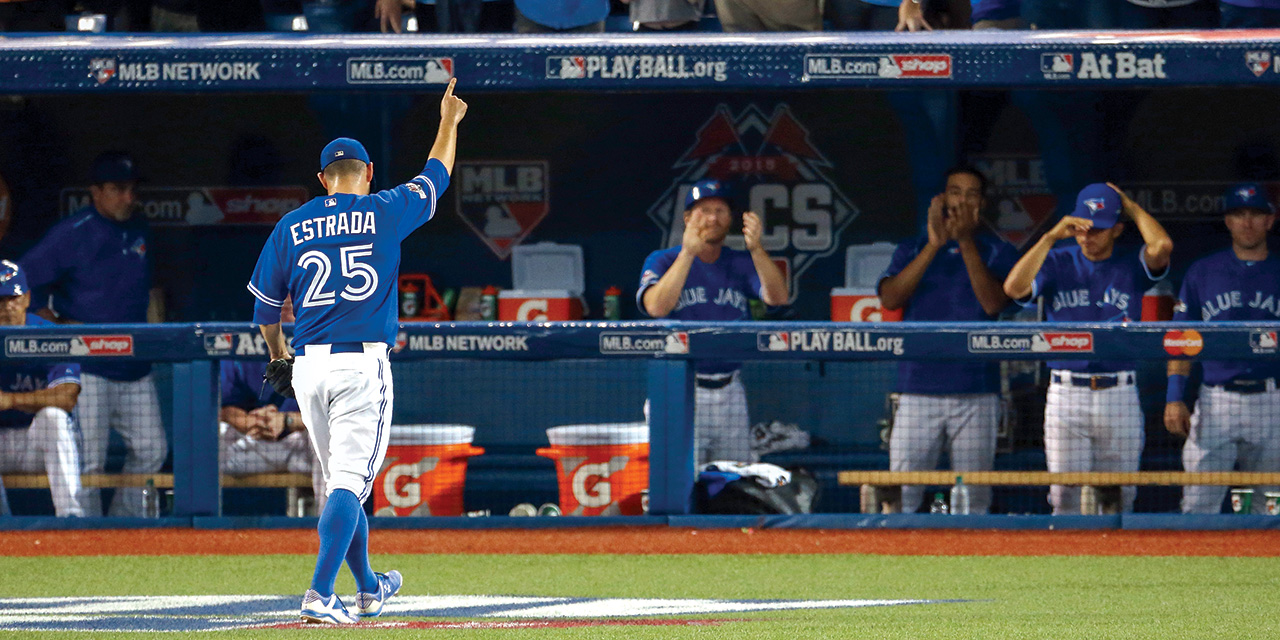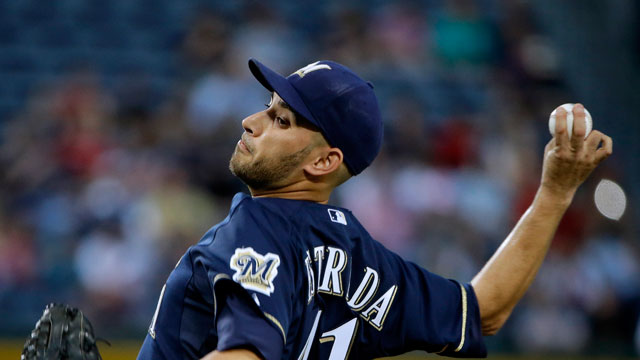Marco Estrada remembers only a few things about Sonora, Mexico, where he was born. His little house on the short street where he grew up. The handful of toddler friends and the dusty yard out front where they played. The bodega up the road. No car, no air conditioning, no TV. Just a nice, simple life.
But what he remembers most is the day his mom, Silvia Mariza Estrada, started packing his things and told him they were heading north. Estrada’s aunt, Norma, had already made that move with her husband, settling in Sylmar, Calif., and sent word that they had space to take in her sister and five-year-old Marco. Estrada’s father was long gone; he left when Marco was too young to make memories. Estrada couldn’t tell you what he looks like; couldn’t tell you his name. All Estrada knows is he has a half-brother and sister out there somewhere. They contacted him once when he was in his early twenties but he never figured out how to reach them. He wants to meet them someday. Maybe when baseball’s over. And his father? “Him,” Estrada says, “I couldn’t care less about.”
Once they were stateside, Silvia worked long, demanding days as a nanny for wealthy Beverly Hills families. She left early in the morning and came back well into the night, leaving Marco with Norma, who made sure he got to school and stayed out of trouble. Silvia had just two primary rules for Marco while she was gone: He had to listen to everything Norma told him, and he absolutely had to do something organized and productive with his time once school was over. No sitting around at home; no idling outside some convenience store. Estrada chose baseball. And about a quarter of a century later, he got to do something he’s been waiting for his entire life: He told his mom she doesn’t have to work anymore.
The two-year, $26-million contract Estrada signed this past off-season helped with that. It was a fitting reward for the Blue Jays starter, who, at the age of 31, became one of the most quietly dominant in baseball last season, pitching to the fifth-best ERA in the American League and finishing 10th in Cy Young voting. It certainly took him a while to get there, through more than 10 years of pro ball, two trades and a bevy of changes to his mechanics and arsenal. But you can trace everything he’s accomplished back to Silvia’s unwavering work ethic and determination for her son to make something of himself.
“My wife and I, we’ve got two kids,” Estrada says. “And some days it can be extremely difficult raising them. So I can’t imagine what my mom must have gone though doing it all by herself.”
Estrada’s had a lot of validating moments lately, from proving he belongs in the Blue Jays rotation, to starting crucial post-season games, to being named an all-star for the first time in 2016. But giving something back to the person who gave everything to him was the biggest moment of all. “My mom did an incredible job. Over time, you learn to appreciate these things—how hard she’s worked her entire life,” Estrada says. “Getting to tell her she doesn’t have to do that anymore, that was extremely satisfying. It meant everything. It was the best moment of my career.”

Sylmar, a mostly Latino neighbourhood near the San Fernando Valley in L.A., is a tough place to grow up. More than a third of the population hasn’t completed high school; crime rates are well above the national average; plenty of local youth end up in gangs. Estrada remembers hearing police helicopters passing overhead when he was walking home from school.
Norma accompanied Estrada on those walks, and made sure he was fed and his schoolwork was done. Norma’s husband, Carlo, a former ballplayer who played a year in the Mexican league and threw Estrada his first pitch, was another strong influence. Carlo was obsessed with the game (his brother, Oscar Mejia, made it to triple-A as a middle infielder in the Texas Rangers organization) and had Estrada out in the yard every day working on fundamentals and playing wiffleball with his cousins. At Silvia’s urging, Estrada began playing organized baseball when he was six, skipping T-ball and going straight to Little League where he played second base and shortstop.
Estrada never pitched in earnest until his senior year of high school, when he finally made Sylmar High’s varsity team as a skinny third baseman. A coach watched him throwing bullets to first base and asked if he’d ever consider doing it from the mound. “I was like, ‘Sure, why not?’” Estrada says. “I was just playing ball because I loved it. Not because I thought I was going to the big leagues or anything. So, whatever they wanted me to do, I was going to do. I picked it up pretty quick. I basically became the best pitcher on the team that year.”
As it happens, Div. I colleges don’t make many calls to undersized players from disadvantaged communities who only cracked their high school’s varsity team in senior year. But Jon Strauss, a baseball coach at nearby Glendale Community College (a school of fewer than 20,000 students that, yes, did inspire NBC’s cult classic Community), had seen Estrada throw and saw plenty of untapped potential. Strauss was put on to Estrada by a few of his players who had been teammates of the right-hander growing up. Those players turned out to be a significant help even beyond the initial scouting tip-off, as every time Strauss called the Estrada residence to try to recruit the 18-year-old, he had trouble getting Marco on the phone. “You’d call his house and nobody spoke English,” Strauss says. “I couldn’t get ahold of this kid. So, eventually I started getting some of my players to make the calls because they spoke Spanish. That way I could at least talk to Marco.”
Strauss couldn’t offer a scholarship, or many perks at all. What he could sell Estrada on was the proximity to his home in Sylmar, about 30 minutes away, and a baseball program that had already attracted some of his former high-school teammates. Strauss never let on at the time, but he really wanted to recruit Estrada, and not only because of his talent. “He had overcome more in his short lifetime than most kids do in their whole lives,” Strauss says. “You like those kinds of guys because they’re survivors and they’re not going to back down from anything. He had no money. He couldn’t afford all the nice gadgets and cleats and lessons. He could easily have been in a gang. He could have gone in a very different direction considering what he was surrounded by.”
Estrada closed for Glendale in his first year before becoming a starter as a sophomore and pitching to a 2.79 ERA in 14 games, striking out 110 batters in 84 innings. Still, baseball was never something anyone thought Estrada would do for a living. Glendale provided an opportunity for him to not only get an education but stay close to both his mother and his girlfriend, Janai, who he met at a cousin’s birthday party when they were 17. Estrada studied criminal justice; he figured someday he could be a parole officer and coach baseball on the side. It would be a nice, simple life.
But what everyone who knew Estrada from those days always comes back to is how blissfully unaware he was of the potential he had. “He was so shy. I always had to let him know how good he was,” Strauss says. “There was just no arrogance about him; no cockiness. I had to really drag him out of his shell. He was so reserved.”
Strauss mentored Estrada closely, making sure he always had a teammate to drive him to school, and that he was going to classes and completing his schoolwork. Estrada was far from a model student. But Strauss knew that if he looked after his grades, Estrada could pitch well enough to earn a scholarship at a four-year college. Strauss had played ball for nearby California State University, Long Beach—everyone calls it Long Beach State—during the program’s glory days in the early ’90s when it emerged as a national power despite little acclaim (that helped breed the revered “Dirtbag” moniker the team has carried since). Strauss took his young pitcher to a handful of Long Beach games at Blair Field, where Estrada fell in love with the team’s underdog, scrappy culture.
One day, Strauss gave Estrada one of his old brown Rawlings gloves with “Dirtbag” stitched into it and told him that if he would take his schoolwork seriously, he could be a Dirtbag himself. “I saw the things in him that that program recruited. They liked guys that nobody wanted. Guys that had backstories,” Strauss says. “As I got to know Marco, I thought, ‘This guy’s perfect.’”
During Estrada’s second year at Glendale, Strauss organized an exhibition game against his alma matter. Jered Weaver started for Long Beach. He was about to be the 12th-overall pick in the MLB Draft, and would one day win 20 games in the majors and make three all-star teams. Estrada—all six feet and 150 lb. of him—started opposite Weaver, holding his own against Div. I hitters. Troy Buckley, a Dirtbags coach at the time, was blown away. “He was obviously very green. I don’t think he really knew how talented he was,” Buckley says. “He had this filthy, hard, four-seam, whiteball, big-rotation, yellowhammer, snapdragon curveball. This thing was a good, good pitch.”
Buckley knew right away he wanted Estrada and began recruiting him. As an underprivileged Latino from a single-parent home, Estrada qualified for a tremendous amount of financial aid, which, along with athletic scholarships, covered his entire tuition and then some. Suddenly, the 21-year-old had his own apartment in Long Beach, a bevy of new equipment he’d never been able to afford and access to the university’s fitness and nutrition facilities. He started putting on muscle, gaining 30 lb. throughout the season, which in turn boosted his fastball velocity to the mid-90s. Now he had powerful stuff to combine with his pinpoint command and tumbling breaking ball. He pitched to a 2.43 ERA in 18 games for the Dirtbags, leading the team in strikeouts with 104.
That’s when MLB interest started flooding in. Practically every team in the league called him, trying to collect intel on the Long Beach ace nobody had ever heard of. After going unselected out of high school, Estrada was now being told he’d go somewhere between the second and fourth rounds in the 2005 draft. “He just kept getting better. And quickly, too. I guarantee you at Sylmar High School nobody thought this kid was going to be playing in the big leagues,” says Chris Cicutto, who coached Estrada at Glendale. “But he sneaks up on people. Just like the way he pitches. In games you’d see guys go, ‘What’s going on? This guy shouldn’t be that special. But he’s pretty darn good.’”
Estrada went in the sixth round to the Washington Nationals. He was assigned to low-A Vermont in the New York-Penn League and couldn’t have hated it more. He had never pitched anywhere other than Southern California, never dealt with long bus travel, never been away from Silvia and Janai, never been outside his comfort zone. “I’m playing baseball, and I love baseball so much. But everything outside the game sucks,” Estrada says.
The results reflected his displeasure, as Estrada pitched to a 5.08 ERA in that first season and then a 5.59 ERA in his first shot at A-ball. Still, the Nationals kept advancing him, and by the end of his third professional season he was in high-A Potomac. That’s where Estrada met Clint Everts, a first-round pick who was going through his own rough transition to pro ball. The pair became fast friends, commiserating over their shared struggles. One day, Estrada asked Everts to show him how he held his change-up, a pitch Estrada had never quite figured out. The grip felt good. “I used it the very next outing and it went really well,” Estrada says. “It completely changed my approach.”
Now Estrada had an elite change-up to throw off his fastball and hitters had fits with it. He started his next season in double-A, pitching to a 2.66 ERA in 13 starts, and finished the year in the Nationals bullpen. “Something just clicked; I just figured out how to pitch,” Estrada says. “Everything just kind of fell together.”

Of course, there were still setbacks to come. After the 2009 season, Washington took Estrada off their 40-man roster without informing him, letting him find out when Milwaukee claimed him off waivers. As a Brewer, he missed large stretches with a broken collarbone and persistent shoulder tendinitis. Milwaukee shuttled him back and forth between the rotation and the bullpen, eventually deciding he would be a reliever for good in mid-2014 after Estrada allowed 27 home runs in his first 18 starts of the year. Shortly after the season they shipped him to Toronto for Adam Lind in a move that, at the time, was met with a notable lack of enthusiasm by Blue Jays fans. You can ask Estrada about that.
“Look, I always try to stay away from reading stuff. But I was going to a new team, so I wanted to see what people thought. And I’m reading all these stories, comments, whatever—and no one was happy. Fans, media—like, no one,” Estrada says. “I was like, ‘All right. Time to stop reading this and prove everybody wrong.’”
A spring-training ankle injury hindered that pursuit and nearly spelled the end of his time with the Blue Jays, as the team internally debated including him on the major-league roster until the final days of spring training. They ultimately took him north as a reliever, and gave him a chance in the rotation a month into the season. All Estrada’s done in his nearly 50 starts since is pitch to a 3.05 ERA, allow the fewest hits per nine innings of any American League pitcher, and post the sixth-lowest batting average on balls in play (.217 in both 2015 and 2016) in the 115-year history of the American League. Meanwhile, he’s further developed that changeup, refining it into a pitch generally regarded as one of the best off-speed weapons in baseball. Estrada’s used it nearly 30 percent of the time since the beginning of 2015 and opposition hitters are batting just .167 against it. He’s also overhauled his mound mindset, learning from long conversations with veteran Blue Jays such as Mark Buehrle and David Price. Estrada’s adopted a monk-like mentality when it comes to the game, staying focused on the process, damn the results.
Estrada says that last part has been the most crucial element to his success. On the advice of Buehrle, he no longer throws bullpens, goes over scouting reports or worries about how his stuff feels on any given day. He trusts his pitches, throws exactly what the catcher calls every single time, and focuses all of his energy on simply hitting the glove. The rest, Estrada says, will take care of itself. “I truly don’t let things affect me anymore like they used to. It’s easy to say you won’t, but it’s hard to do,” Estrada says. “But once I got over that hump, and learned to have conviction behind every single pitch, to just trust my stuff and my catcher and that if I execute the right way there’s not much a hitter can do about it—it changed my entire world.”
Others have noticed the changes in Estrada, as well. Buckley travelled to Toronto this past September along with one of Long Beach State’s biggest donors to meet Estrada and fellow Dirtbag Troy Tulowitzki. They watched Estrada throw 6.2 innings of two-run ball against the New York Yankees in the thick of the AL East title race, and talked with him after the game. Buckley hadn’t seen Estrada in a while and couldn’t believe how much he’d grown. “I just see this comfortableness with him now. I see this security. I see this higher self esteem,” Buckley says. “I see a really complete, fantastic pitcher. I think it’s just taken him a little bit more time to put it all together than some other guys because he’s built a little differently.”
It’s true: Estrada’s not your typical all-star athlete. He’s so laid-back, so unaffected. He’s been one of the best pitchers in baseball over a season and a half but hardly anyone’s noticed because he doesn’t even seem to notice it himself.
When you think about it, Estrada was at the centre of some of the Blue Jays’ most indelible moments of 2015. He carried no-hitters into the eighth inning in back-to-back starts; he threw six-and-a-third innings of one-run ball against the Texas Rangers in game three of the ALDS, the turning point of that series; he threw a gem in game five of the ALCS, another win-or-go-home game, facing the minimum through six and nullifying a Kansas City Royals offence that scored 14 runs the day before.
That ALCS start—perhaps the best by any Blue Jay all season long, considering the circumstances—is a perfect example of how tranquil Estrada can be. Think about how calmly and efficiently he dominated a tenacious Royals offence in that game. Think about the complete absence of emotion he showed throughout. Think about how he left the mound with two out in the eight inning, after the most important outing of his team’s season and his own career, handing the ball to a gobsmacked John Gibbons—the Blue Jays manager simply said “Wow” as he took it—while 50,000 people lost their minds, and kept his head down as he walked to the dugout. That’s why he manages to creep beneath the radar. He addresses all of his success with a shrug both sober and stoic. No big deal; nothing to see here. The spotlight passes right over him, and you know he’ll be the last guy to chase it.
But he cares—he really, really does. It’s just not in him to show it. “Marco’s never going to look for the limelight. He just wants to do his thing, get his work in, and then slide out unnoticed,” Buckley says. “He’s such a fantastic kid. He really never wants to bother anyone.”
Buckley has a story that sums up just what he’s trying to convey. His school hosted the Long Beach Regional in 2005, a qualifying tournament for the College World Series. Buckley had scheduled Estrada to pitch the Dirtbags’ second game on June 4 vs. USC. Thing is, Estrada’s lease on his Long Beach apartment expired on the first of the month. Normally, if players didn’t have accommodations during regionals, Buckley would put them up in a nearby hotel. That’s what he did with a group of freshmen who had been living in dorms. But the ever-unassuming Estrada didn’t want to make a fuss, and kept it to himself, opting to sleep on a friend’s floor for three nights before his start. Estrada pitched well through four innings of the crucial game—dueling future big leaguer Ian Kennedy—before Buckley got word that his young starter was pitching through back discomfort. Buckley asked Estrada what had happened. Did he tweak it in warm-ups? Did something flare up on a pitch? Blissfully honest, Estrada told him the truth. “I start losing it. Like, ‘Marco, are you kidding me?’ You’ve been sleeping on a floor?’” Buckley says. “That was just quintessential Marco. He never wanted to make any waves. Never wanted any special attention. It’s just him in a nutshell.”
Nothing’s ever been given to Marco Estrada. Not in Mexico, not in Sylmar, and certainly not in the majors.
“It’s been like that my entire life. I’m so used to it by now. I’m always fighting for it,” Estrada says. “And that’s fine. Really, it is. Not everyone’s going to be, like, [Clayton] Kershaw or whoever, where you’re just incredible and ‘the man’ your entire life. Some of us take longer to put it together. And I just went through enough crap, I guess, to get to this point where I’m feeling pretty good about myself. It’s been a long process.”
There will no doubt still be questions. Estrada’s emergence has been so sudden, so deep into his career, that every misstep will be painted by someone as a sign of bad things to come. Things like that would have bothered Estrada when he was younger, but not anymore. He knows the struggles and the doubts are part of the process. He knows that every shred of adversity he’s encountered helped get him to this past winter, when he made good on the biggest goal he’s ever had and told his mom she could retire. Silvia still lives with her son—in Peoria, Ariz., now—looking after his house while he’s in Toronto. It’s a bit different than the little place on the short street in Sonora. There’s a car, air conditioning, TV. But it’s still a nice, simple life.




